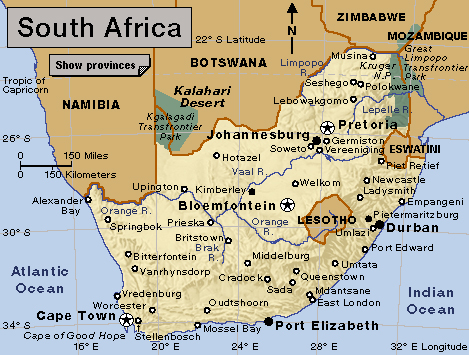Durban << DUR buhn >> is South Africa’s chief seaport and one of its largest cities. It lies in the province of KwaZulu-Natal. The Zulu name for the city is eThwekeni.

Durban is a resort city and a trading and industrial center. The city lies on the Indian Ocean. It spreads out from the Bay of Natal, which forms an excellent natural harbor.
People.
English is an important language in Durban. People of African ancestry make up the majority of the city’s population. Most of the Africans are Zulus who speak the Zulu language at home. People of Indian and other South Asian origin make up the second largest group. These people are mainly Hindus, but some are Muslims or Christians. Many of Durban’s white and Coloured (mixed-race) residents have British ancestors. Durban attracts many immigrants from other parts of Africa and elsewhere.
Education and cultural life.
The University of KwaZulu-Natal has several campuses in the Durban area. The university was formed in 2004 by the merger of the University of Natal and the University of Durban-Westville.
Dramas, operas, ballets, and other cultural events take place in many private locations and in Durban’s Playhouse Theatre complex. Durban’s City Hall is a replica of City Hall in Belfast, Northern Ireland. The KwaZulu-Natal Philharmonic Orchestra performs in Durban’s City Hall. The Durban Natural Science Museum and the Durban Art Gallery are also housed in City Hall.
Durban has many Hindu temples and Muslim mosques. Alayam Temple is one of the largest and oldest temples in South Africa. The Juma Masjid Mosque is the largest mosque in the Southern Hemisphere.
Economy.
Business in and around the harbor forms the hub of Durban’s economy. Port facilities handle tens of millions of tons of cargo a year. This cargo includes coal, grain, and petroleum products. Factories in Durban produce automobiles, chemicals, clothing, food, metals, paper, petroleum products, and textiles.
Durban also depends heavily on the tourist industry. With its pleasant climate, Durban is South Africa’s most popular resort city. In addition, the city has a large international convention center, as well as an impressive array of sports facilities and stadiums. Durban’s central beachfront is known as the Golden Mile.
History and government.
Cattle-keeping farmers, probably speaking Nguni languages, inhabited the Durban area many centuries ago. The first recorded European visitor to the area was the Portuguese navigator Vasco da Gama. Arriving there on Christmas Day (December 25) in 1497, he named the area Natal. Natal is the Portuguese word for Christmas.
In 1824, a group of ivory traders from the surrounding Cape Colony established a trading settlement in the area. They called it Port Natal. The settlement grew, and in 1835, it was renamed Durban, after Sir Benjamin D’Urban, governor of the Cape Colony.
Development of the harbor began in the mid-1800’s. In 1886, the world’s richest gold field was discovered on the Witwatersrand in South Africa’s interior. Durban became an important port serving the gold mines, and it experienced rapid growth. In the early 1900’s, a channel was created to open the Bay of Natal to ocean-going vessels. Since then, the port has been continually improved, and sections of the bay have been filled in. Durban achieved city status in 1935.
From 1948 to 1991, South Africa had a system of strict racial segregation called apartheid. The separation of racial groups worked to the advantage of the white minority. In the mid-1990’s, after the end of apartheid, the Greater Durban metropolitan area was restructured to promote integration. The administration of the region was divided between an elected council for the entire metropolitan area and local elected councils for six metropolitan “substructures.” A number of formerly separate suburbs, townships, and other areas became part of the city of Durban. Several of these communities had been separate apartheid townships for Black Africans. Others had been separate apartheid townships for Indians. Still others are traditional authority areas governed by Zulu chiefs.
By 2001, the city of Durban, including all of the communities it had absorbed in the mid-1990’s, had become part of the eThekwini metropolitan municipality, or “unicity.” A mayor and a municipal council oversee the eThekwini municipality. The municipality covers an area of 887 square miles (2,297 square kilometers) and has a population of 4,239,901.
See also KwaZulu-Natal; KwaZulu-Natal, University of.
